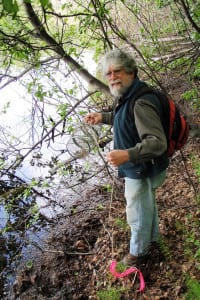The creation of a freeway in Los Angeles put Michael Bell on the road to his career choice. When Bell was about 12 years old, construction near his home cut through rocks that contained a treasure for him: fossil fish.
“I formed a relationship with the Natural History Museum in LA County and started bringing fossils [to them],” Bell recalled. “I had friends who would do it for a week or two and then they’d had enough. I did it endlessly. In a way, that’s how my career started.”

Indeed, that career led him to Stony Brook University, where he arrived in 1978 and is a professor in the Department of Ecology and Evolution. Bell was co-editor of “The Evolutionary Biology of the Threespine Stickleback” in 1994 with Susan A. Foster.
Recently, the American Association for the Advancement of Science elected Bell as a Ffellow. Bell said he appreciated the “broader recognition of his work.”
Those who have collaborated with him said Bell is a leader and an exceptional scientist.
Bell’s “contribution to the field has been enormous,” explained Windsor Aguirre, a former graduate student who is an assistant professor in the Department of Biological Sciences at DePaul University who still works with Bell. “Many of the most important papers in the field have been made possible or greatly enhanced [by Bell’s efforts],” he said.
From those early days, Bell has focused on the threespine stickleback, a fish that used to be considerably more prevalent at Flax Pond in Old Field and in the Great South Bay.
This particular fish, whose three sharp spines on the top of its body prevent some predators from swallowing it, appeals to scientists for a host of reasons — from the variation it exhibits within and among populations to its relatively small size and ease of maintaining in a lab.
Bell has focused on establishing the relationship between traits and environmental factors. These fish can live in the sea — where they contend with the usual saltwater dilemma, where the concentration of salt is higher than in body fluids — and in freshwater, where salt is lower than in their body fluids.
Like salmon, they breed in brackish water (water that’s in between fresh and salty) and freshwater. The population of fish that evolve in freshwater can continue to survive despite having marine ancestors.
Indeed, the evolution, through mutations, of these fish is so rapid that they defy Charles Darwin. Coming up with the theory of natural selection when he studied the many unique birds in the Galapagos Islands 600 miles off the coast of Ecuador, Darwin believed that evolution occurred on an almost imperceptibly slow time scale.
“Darwin underestimated the potential for rapid evolution,” Bell said. “He believed evolution is slow.” Sticklebacks have traits that evolve at high rates.
Bell has studied stickleback fossils in Nevada and California and modern stickleback in California and Alaska.
He has often studied the armor plates of stickleback, which have a marine and a freshwater version. In the ocean, the freshwater version would theoretically occur only once in about 10,000 young sticklebacks, because it’s a disadvantage to that individual. However, in a different environment, the fish with the freshwater armor plating becomes the natural selection superstar.
In an experiment in Cheney Lake in Anchorage, Alaska, Bell released sea-run stickleback. A year later, none of the fish had the freshwater plates, while fewer than 1 percent had them two years later. Six years after the experiment began, however, one in five fish had these plates.
“When you put the fish in freshwater, it evolves,” he said.
A resident of Stony Brook, Bell chose to live close enough to the university to walk to work. That, he said, was by design because he moved in during the gas crisis in the 1970s and didn’t want to wait in line for gas or struggle to get to work.
Bell and his wife Cynthia Blair travel to farms out east, shop and visit vineyards. Bell enjoys wandering through stores, especially for craft objects, which Blair also likes and makes herself. She designed a pillow of Bell, surrounded by swimming sticklebacks.
After four decades of research, Bell remains as inspired to find fossils and gather evidence about these rapidly evolving and adaptive fish as he was when he was a teenager.
“I won’t ever really retire,” said Bell, although he does expect to cut back so that he can travel with his wife. He appreciates being able to visit the shore of a lake in Alaska and “see what comes up in traps. It’s all still fun — making samples of modern and fossil stickleback, getting results that mean something scientifically and standing in front of a class and explaining biology to them.”
Aguirre, who described Bell as a “great” mentor, suggested that Bell and the stickleback are inextricably intertwined. “The threespine stickleback is truly one of evolutionary biology’s supermodels and [Bell] has played a critical role in bringing the species to the attention of the broader scientific community and the general public.”






